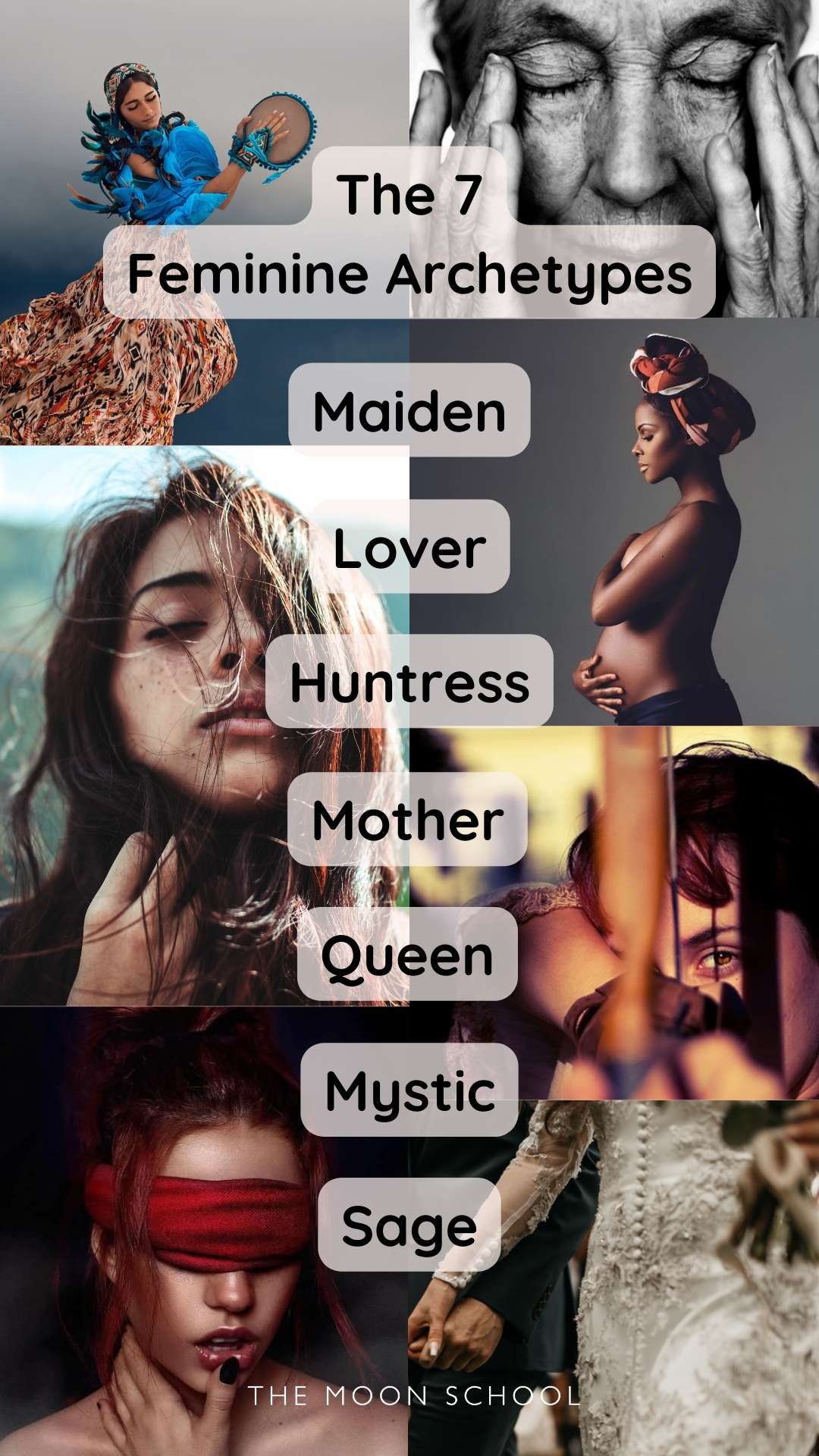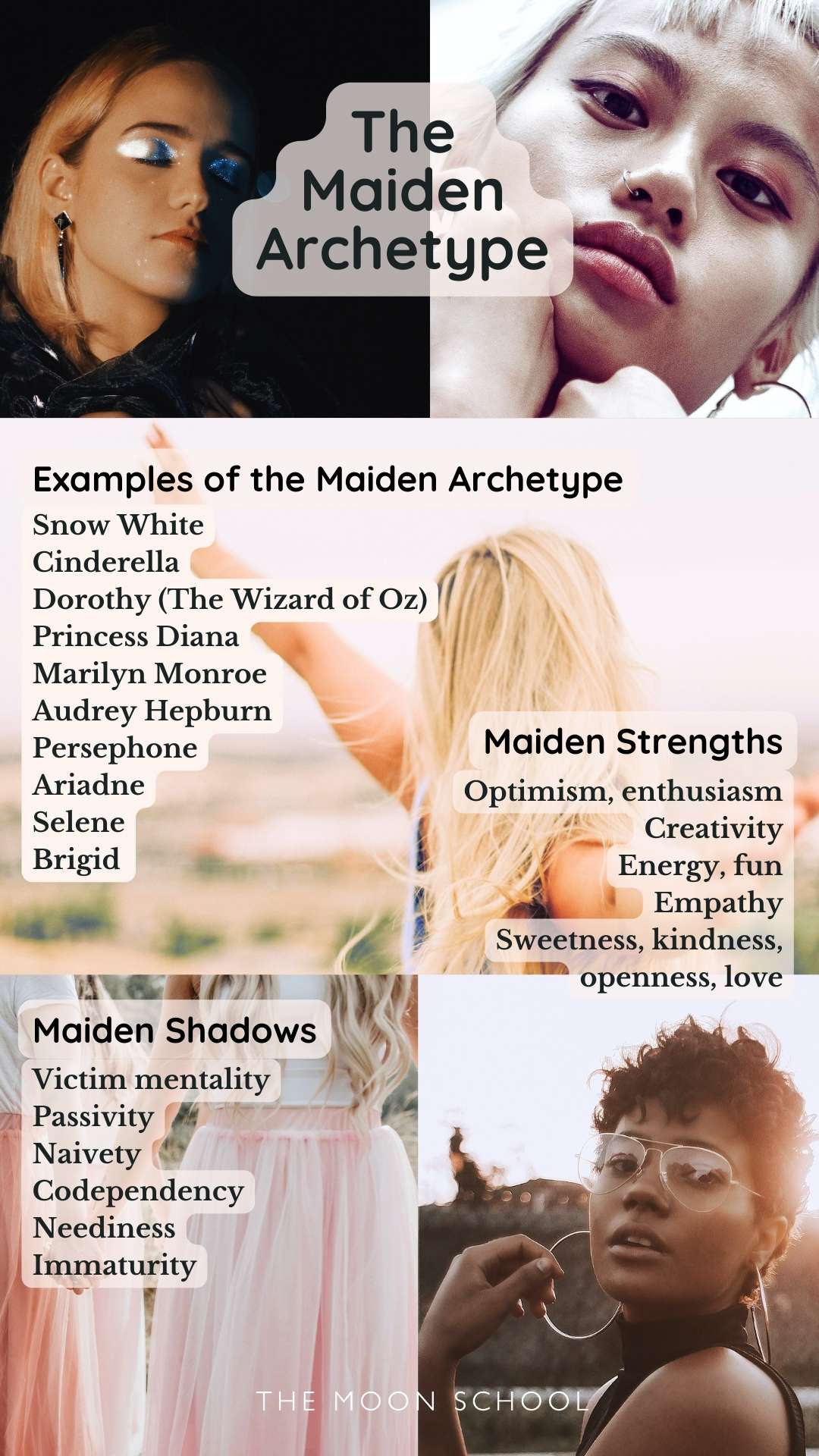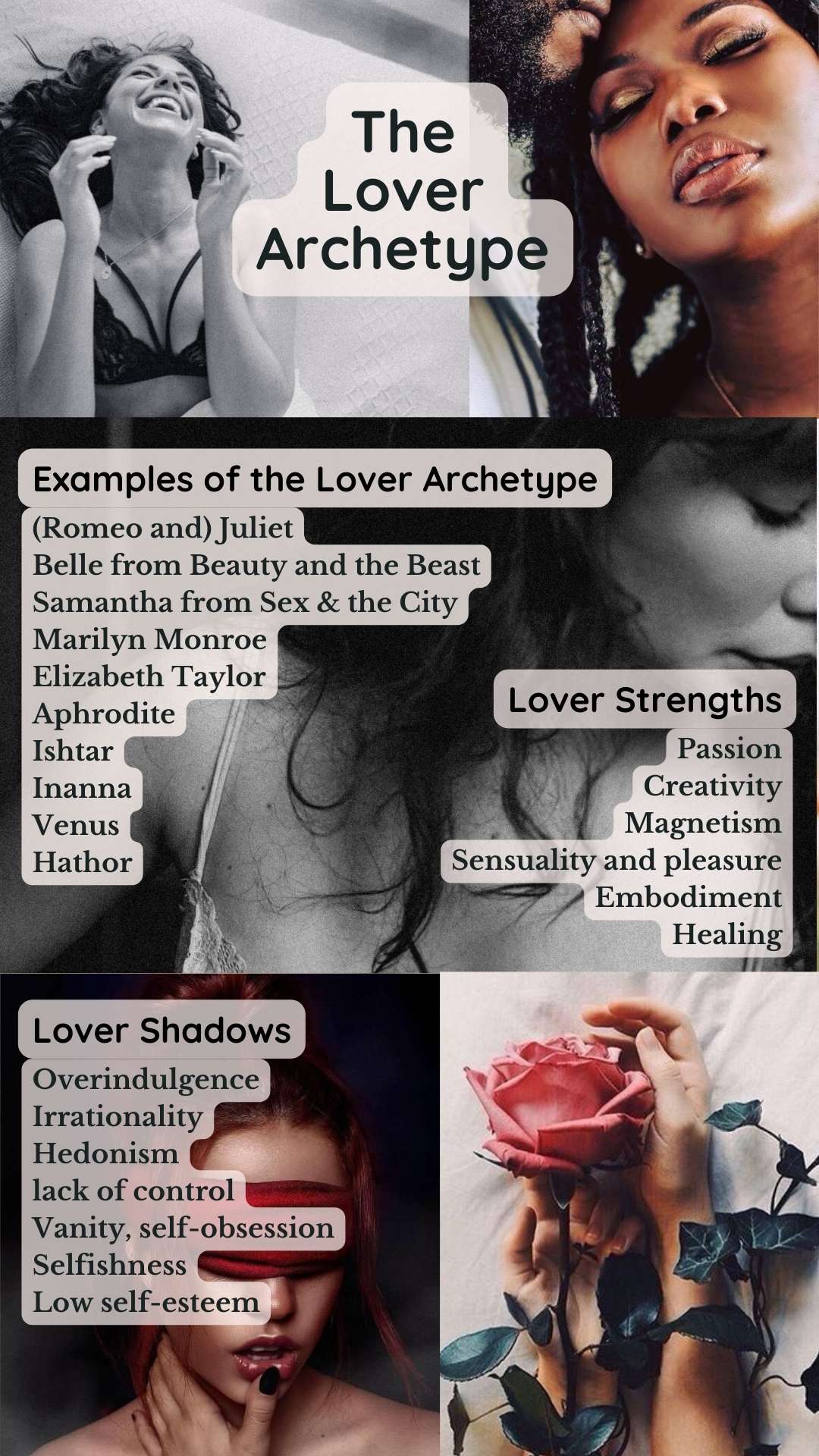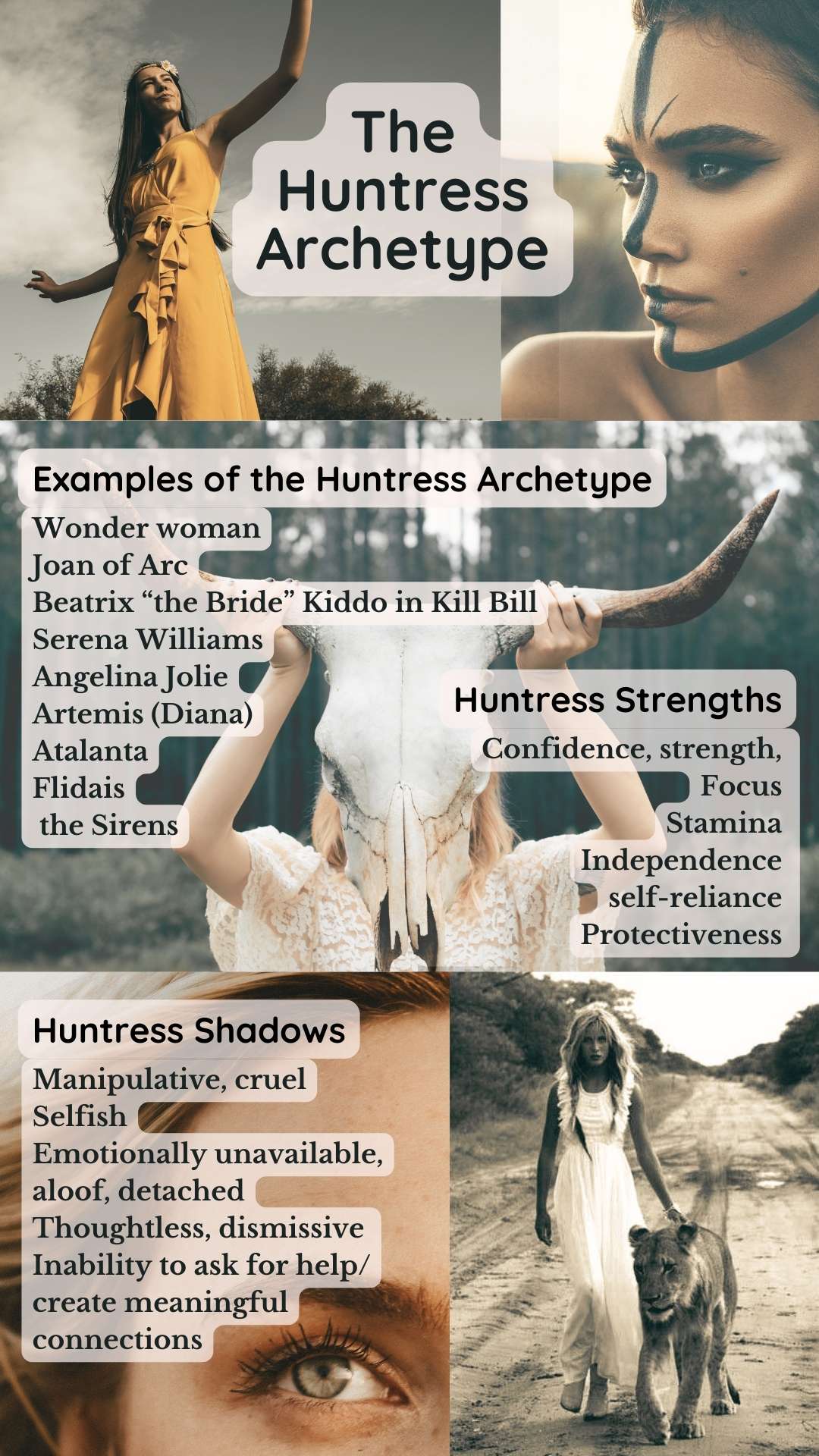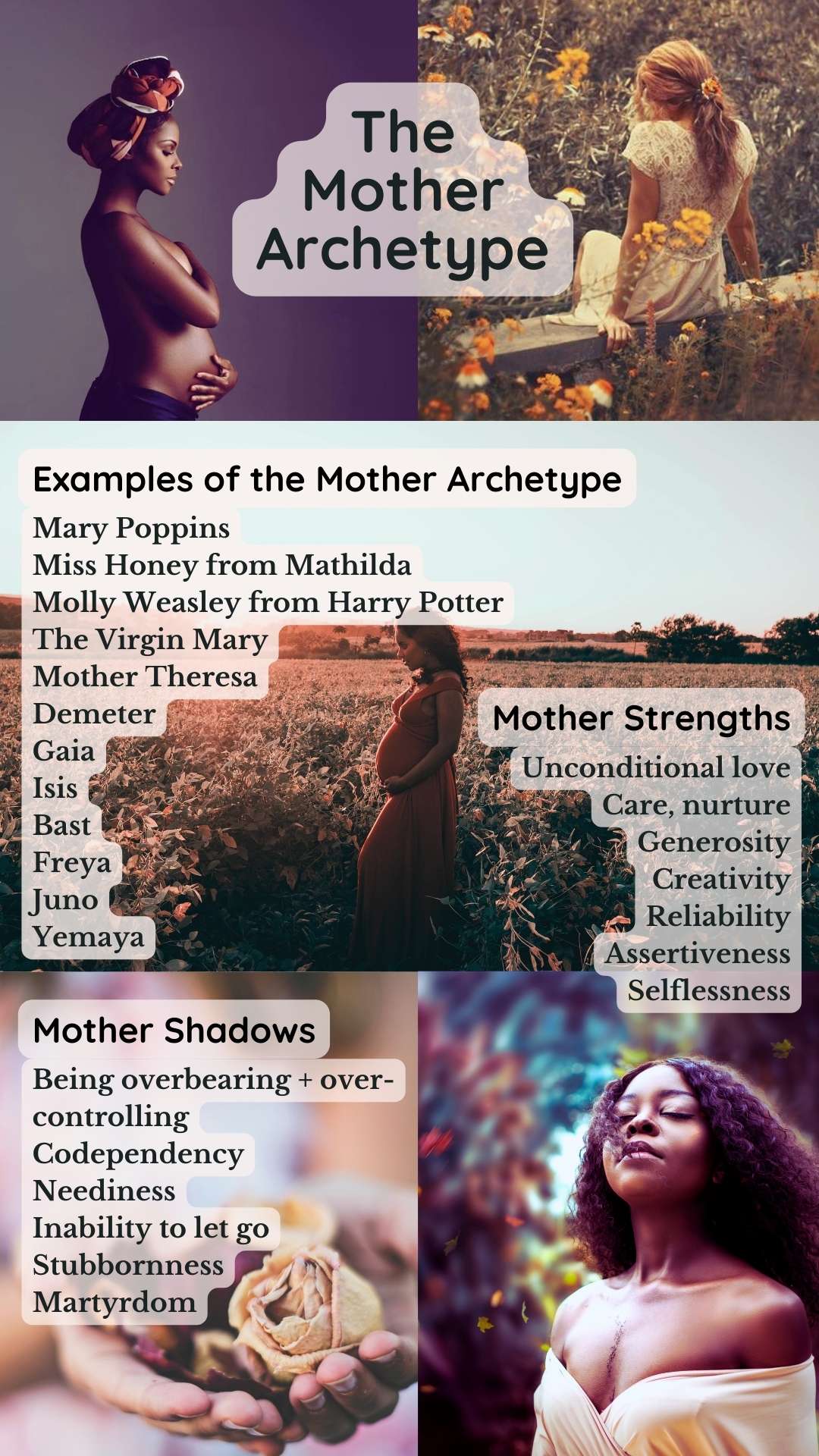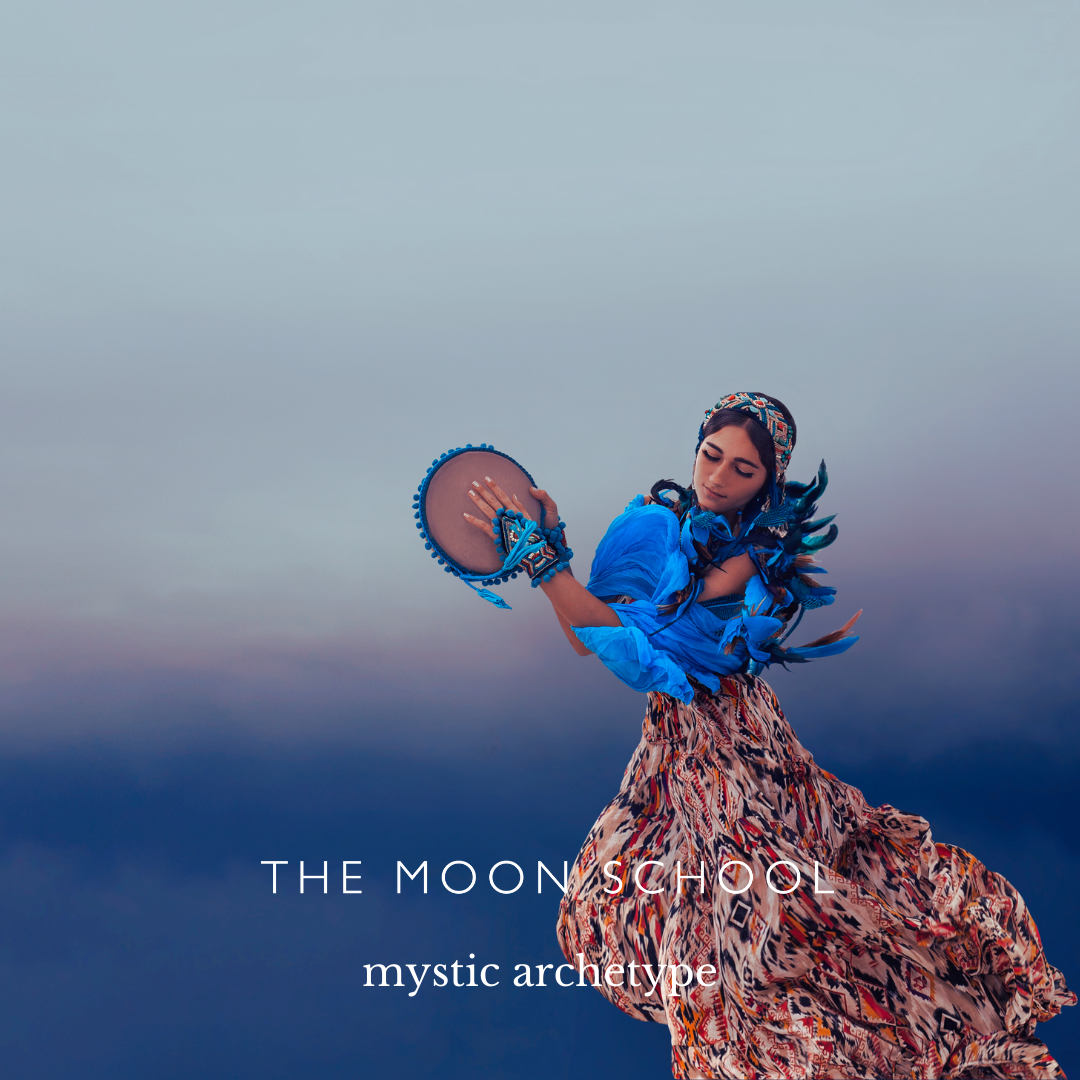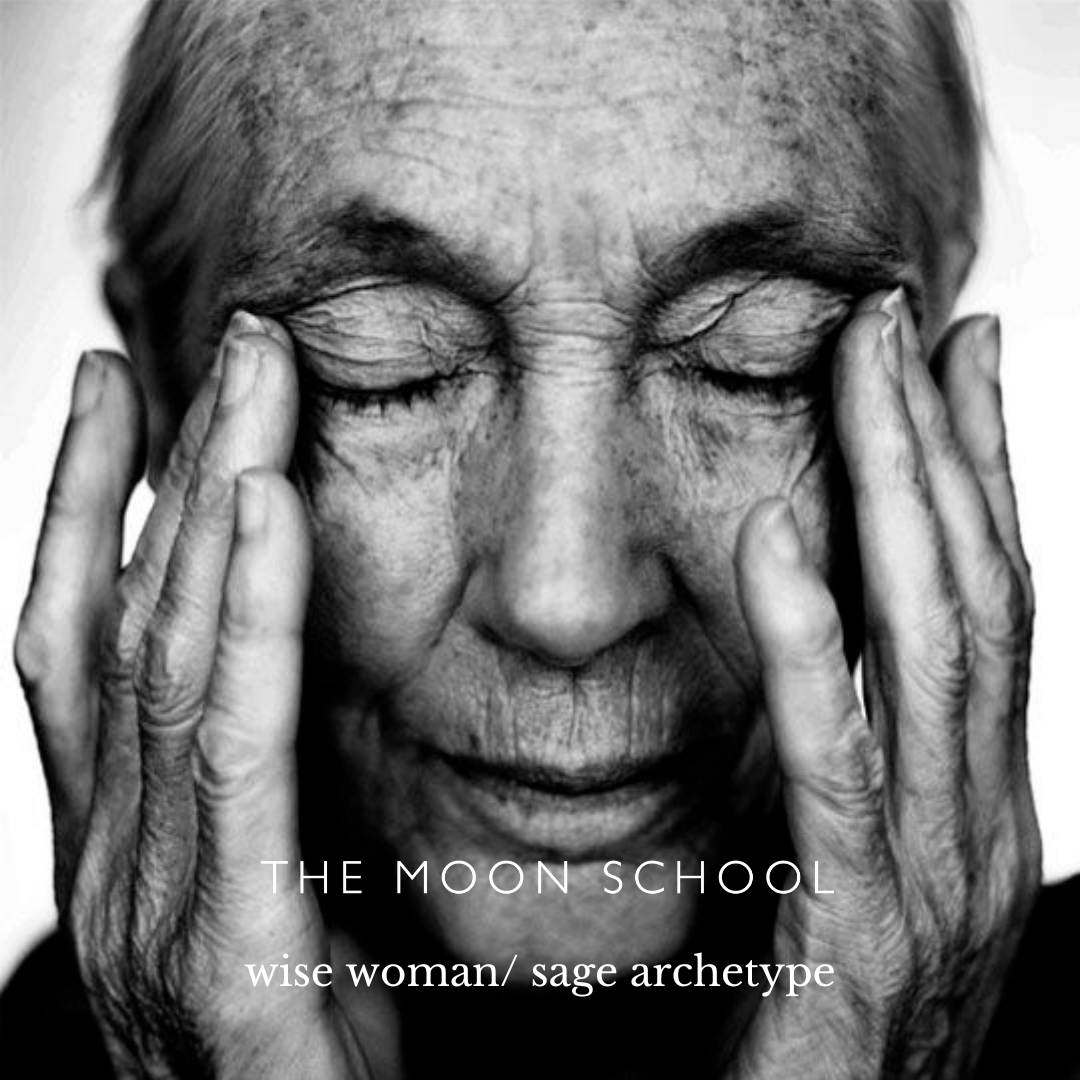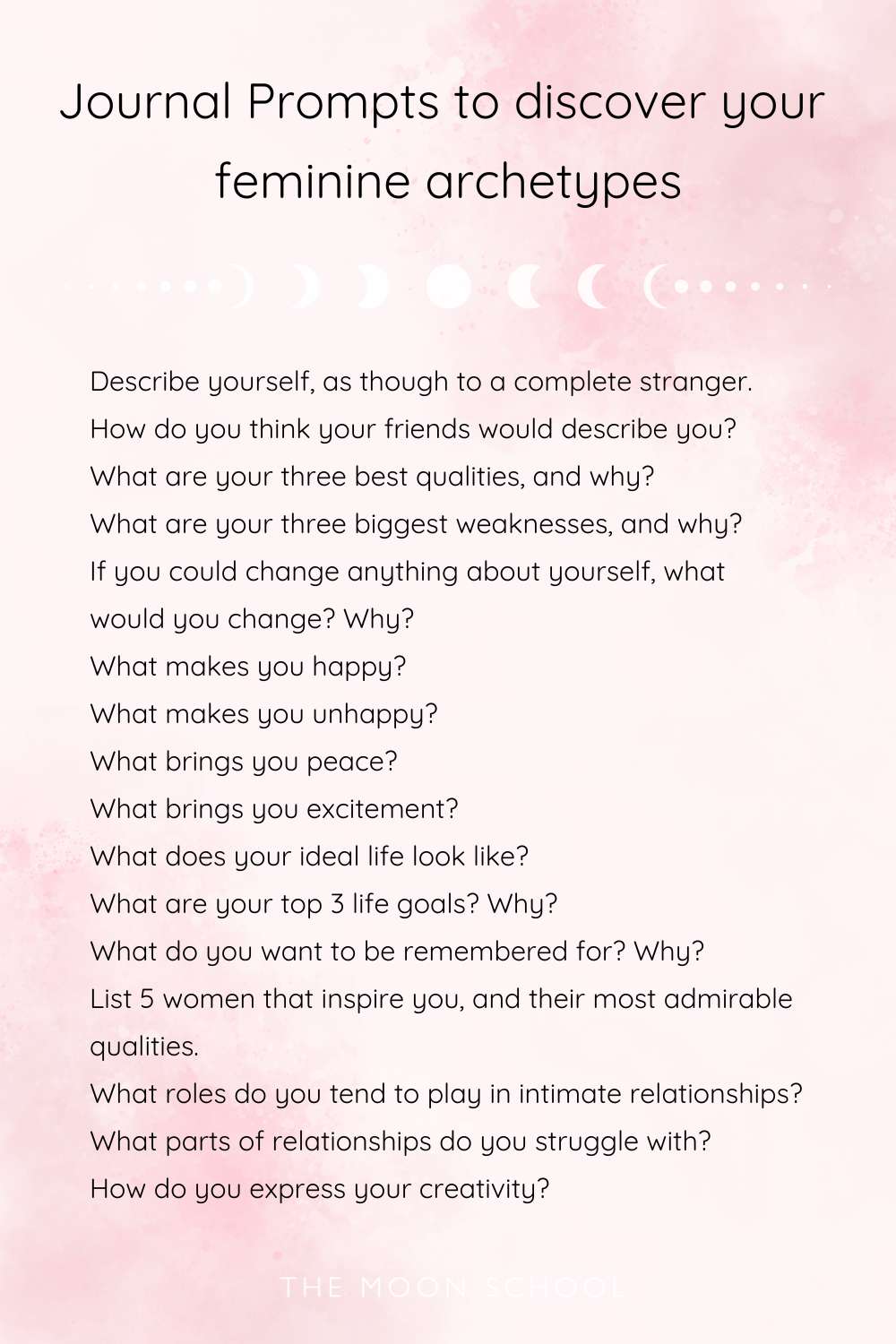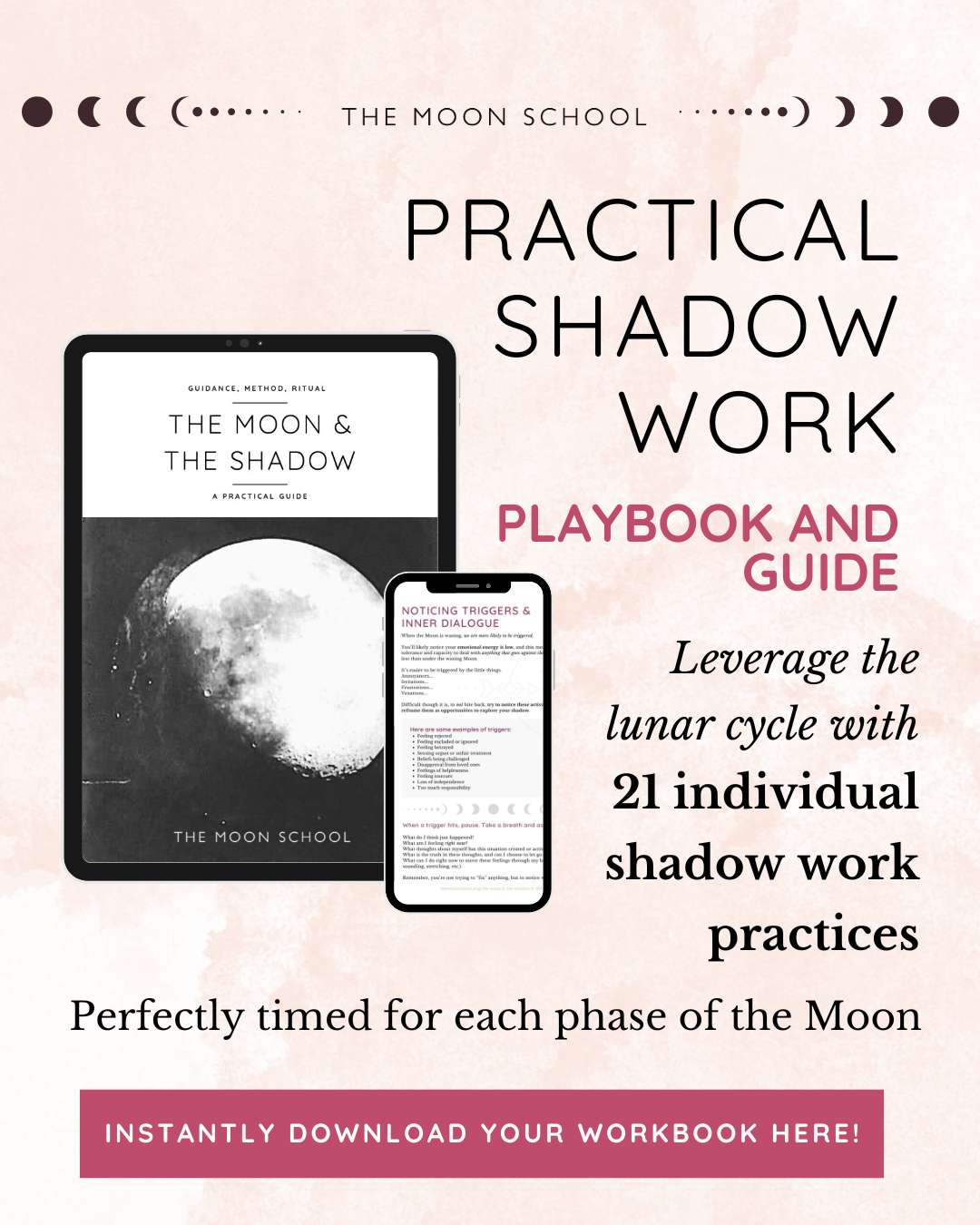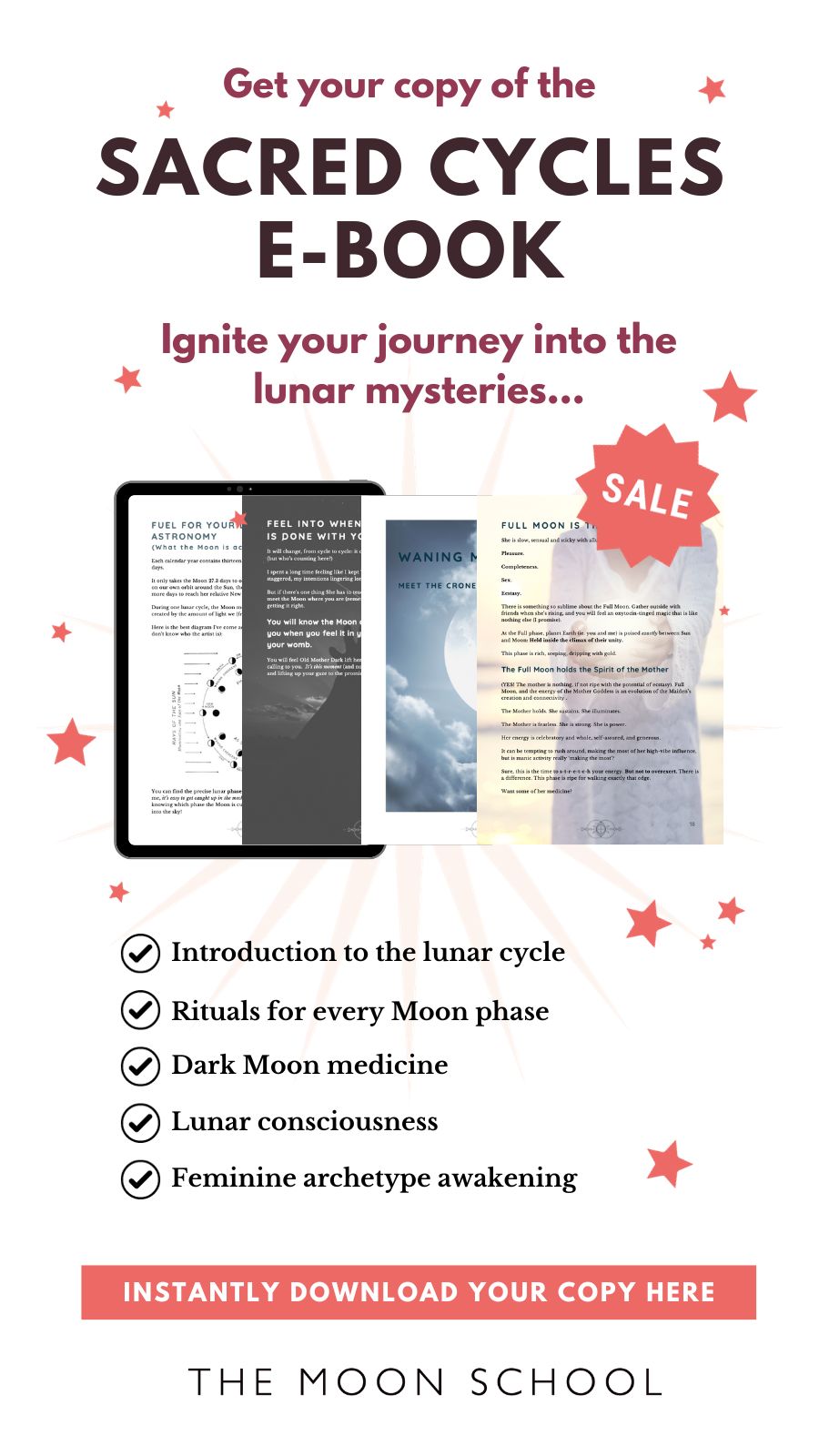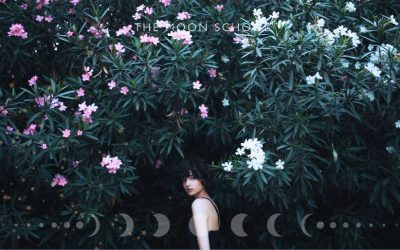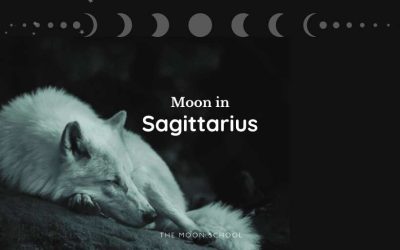Hello, soul seeker! After YEARS of studying the divine feminine through the phases and archetypes of the Moon, I came across an even greater spectrum of feminine archetypes. In truth, there are countless feminine archetypes, but seven of them have continued to inform my life and shape the path I walk through womanhood.
The blueprint of the seven female archetypes was first devised through the Greek Goddesses, by Jean Shinoda Bolen. In more modern times, they were made public by Ayesha K Faines.
Together, the female archetypes make up a powerful set of energy patterns that move through our Western world, shaping no only the personalities of individual women, but how we all relate to life itself.
Each feminine archetype is a sacred symbol
It’s a unique expression of feminine energy, as understood in mythology, psychology, and in cultures and societies around the globe.
Our world is woven through a myriad of archetypes, all containing different strengths, qualities, and weaknesses.
As a woman, getting to know the female archetypes, and learning how to embody and work with them is a powerful way to get to know yourself more deeply. The female archetypes provide a pathway to self-awareness and connection. And also, a way to ride the waves of personal transformation, and, activate and integrate your fullest potential.
You may not embody all the archetypes. In fact, it’s highly unlikely! There will usually be one dominant archetype expressing through you at any one time. And likely two, three, or a handful more that emerge through your life, as you grow and change.
ALso read this: 10 Dark Feminine Archetypes Craving Your Attention
What are the 7 female archetypes?
The 7 feminine archetypes embody each aspect of womanhood, and together they are the maiden, the lover, the huntress, the mother, the queen, the mystic and the sage. Each of these archetypes refers to patterns universally recognized in the collective unconscious.
I’ve asked myself over and over: “Isn’t feminine energy more complex than this?!” Isn’t narrowing the feminine down to seven female archetypes a little reductionist?
But I’ve come to realise that these archetypes are not intended to constrain, they’re here to give structure and holding to an exploration of the fullness of divine feminine energy (beyond the confines of patriarchally defined femininity).
The different archetypes contain powerful universal symbols, that can activate, catalyse and heal.
OK. Let’s take a more details look at each of the 7 feminine archetypes in turn…
The maiden archetype
The maiden archetype embodies purity, innocence, and youth. Her energy is fresh and unaffected, and she seems to move through life with ease, expressing a youthful, trusting nature.
Sometimes childlike, this youthful feminine archetype has a playful spirit, and her energy holds a gentle, affectionate naivety that can win hearts. She seems to trust everyone she meets and lives her life through a cascade of synchronicities and magical coincidences!
This gentle female archetype may appear passive at times. Her naivety can be misconstrued as weak. But the maiden can be daring too. Like the fool in Tarot, she isn’t afraid to take risks (or maybe her innocence keeps her protected from any danger?) So this girlish feminine archetype may seem a little too carefree and even foolhardy at times. But she believes in what’s right. Expressing independence, strength, and unfailing optimism.
The innocence of the maiden archetype makes her idealistic – she lives in the realms of possibility. Sometimes she works with bold, determined autonomy, and at other times collaborates with friends, enjoying common interests.
Although the maiden archetype is most often embodied by women at the start of their journeys into womanhood (ie the maiden phase) her qualities may also emerge later, in more mature women.
Overall, there’s a bubbling, effervescent optimism in the maiden archetype. She’s magnetic – her natural curiosity and vitality seem to attract an audience, and her authenticity keeps it.
Also read: Who is the maiden archetype?
Examples of the maiden archetype in myth
In mythology, the Maiden archetype is embodied by Persephone, the Greek Goddess of Spring who has an innocent, playful temperament and a vulnerable nature. The maiden archetype also appears in Ariadne, Selene, Brigid, and the Muses.
Modern examples of the maiden archetype
Some modern representations of the maiden feminine archetype include:
- Snow White, Cinderella
- Dorothy from The Wizard of Oz
- Princess Diana
- Marilyn Monroe
- Audrey Hepburn
The maiden archetype strengths/ light side
- Optimism, enthusiasm
- Creativity
- Energy, fun
- Empathy
- Sweetness, kindness, openness, love
The maiden archetype dark/ shadow side
- Victim mentality
- Passivity, naivety
- Codependency
- Neediness
- Immaturity
The lover archetype
The lover archetype embodies sensuality, presence, and creativity. Her life force energy is magnetic (to both men and women), charismatic and she has an irresistible appeal.
Charged with a pulse that feels electric, the lover is on fire with desire, bliss, and pure pleasure. But the erotic energy that flows through this powerful and ancient feminine archetype is about so much more than sex. Spend time with her, and you’ll see this woman embodies the primal, life-bringing impulse of nature itself. She dances with eros, savouring her pure feminine energy.
This may emerge as the desire to procreate. But may also express as pure creative instinct. The lover archetype contains the desire and passion to fuel any creative project, drawing in support, funding, and partners, as though they, too, were lovers. To the lover archetype, work is play and play is work, and every moment is celebrated.
This archetype lives in the present moment. Her senses are alive and attuned to the here and now. She cherishes contact with her beloved (whatever form that takes) and craves deep connection. This is where her senses are heightened, and through them, she offers the kind of intimacy and closeness that can catalyze profound healing.
The lover archetype holds the frequency of sacred sensuality, sexuality, and eroticism that used to be recognized and revered in the temple cultures of old. She has the ability to really see and touch people. And her focus on pleasure, can stimulate the sweet waters of healing inside the body.
Overall, there’s an ancient sensuality in the lover archetype. She can heal past wounds, and forge new bonds with her feminine power.
Also read: Who is the lover archetype?
Examples of the lover Archetype in myth
The lover archetype is commonly represented as Aphrodite, the Greek goddess of beauty and love. Also: Ishtar (Babylonian), Inanna (Sumerian) Venus (Roman), and Hathor (Ancient Egyptian).
Modern examples of the lover archetype
This feminine archetype finds representations in:
- (Romeo and) Juliet
- Belle from Beauty and the Beast
- Samantha from Sex & the City
- Marilyn Monroe
- Elizabeth Taylor
The lover archetype strengths/ light side
- Passion, love,
- Creativity, magnetism
- Sensuality and pleasure
- Embodiment
- Healing
The lover archetype dark/ shadow side
- Overindulgence
- Irrationality
- Hedonism, lack of control
- Vanity, self-obsession, selfishness
- Low self-esteem
Curious how this energy shows up in your life?
Check out: 13 Seduction Archetypes: Harness your Raw Femininity for Self Empowerment
The huntress/ wild woman archetype
The huntress archetype embodies autonomy, courage, and focus. She may be athletic, physically striking, and strong, and her energy is usually daring and wild. She’s often referred to as the wild woman archetype or the ‘warriorress’.
Often self-sufficient, and fiercely independent, this divine feminine archetype rarely takes orders or responds well to authority. Freedom and sovereignty are her driving forces. The wild woman/ huntress archetype represents the powerful spirit of female autonomy, and the drive to pursue a life of her own.
The wild woman is often embodied by women who are incredibly self-assured, competent, and ambitious. This feminine archetype has big life goals, and knows how to achieve them. She may be able to climb the career ladder with ease, or set up a business and become an entrepreneur. Like a force of nature, the wild woman cannot (and will not!) be held back. She’s courageous. So try to tame this powerful female archetype and you’ll be sorry!
Because the wild woman archetype represents such freedom, women who embody her energy are rarely regulated by traditional ties like family structures, preferring to live life by their own rules. This feminine archetype will not be a slave to patriarchy.
And, because she represents such strength and empowerment, the wild woman is often found fighting for a cause, particularly around social justice or feminist or other women’s movements. Her fearless attitude can sometimes put her in perilous situations, but this female archetype’s inner wisdom and intrinsic connection to the forces of nature tend to keep her safe.
Overall, there’s an innate strength, and self-reliance that emanates from the huntress. She walks her own path, and both guides and protects those who need her.
Also read: How to Embody the Huntress Archetype
Examples of the huntress/ wild woman Archetype in myth
The huntress archetype appears as Artemis, Greek goddess of the wild and the hunt, often depicted with her bow and arrow, and a deer. Also Diana, Atalanta, Flidais (Celtic), the Sirens.
Modern examples of the huntress/ wild woman archetype
This feminine archetype finds representations in:
- Wonder woman
- Joan of Arc
- Beatrix “the Bride” Kiddo in Kill Bill
- Serena Williams
- Angelina Jolie
Huntress archetype strengths/ light side
- Confidence, strength,
- Focus
- Stamina
- Independence, self-reliance
- Protective, in defense of other women
Huntress archetype dark/ shadow side
- Manipulative, cruel
- Selfish
- Emotionally unavailable, aloof, detached
- Thoughtless, dismissive
- Inability to ask for help/ create meaningful connections
The mother archetype
The mother archetype embodies the maternal instinct that is nurturing, warm, protective, and selfless. The energy of this female archetype is sustaining and generous, whether she directs it towards children and family, or any other aspects of her life.
Aligned with the eternal wellspring of Source, the divine mother archetype offers the sense of belonging and appreciation, that all people long for.
Often down-to-earth, the mother tends to be the most rooted and settled of the divine feminine archetypes. She is abundant and fertile. And like Mother Earth herself, she’s endlessly creative, generous, and compassionate.
Women who embody the divine mother archetype find great pleasure in looking after others. As natural caretakers, they have a deep desire to be of service and provide for other people. Yet those with a dominant Mother archetype may often feel the responsibility of nurturing and sustaining future generations lies in their hands. It’s a heavy weight to bear, but one that’s usually carried with grace.
Of all the female archetypes, this one offers the most strength to others. Existing in relation to those around her, she provides the structure other people need to thrive. From womb to tomb, she cradles, feeds, and protects with endless love.
The mother is also highly attentive. The intimate knowledge and insight that this female archetype has of her brood, gives her an overarching, often protective impulse. She will defend herself (and her family/creation) to the ends of the Earth. Fiercely if she must.
Yet this protective spirit may become cloying and suffocating at times. Centering her life around other people and their needs, the mother archetype may struggle to maintain personal boundaries, and let go of her offspring when the time comes. This sacred feminine archetype often needs to learn to let go.
Also read: Who is the Mother Archetype?
Examples of the mother archetype in myth
The mother archetype appears as Demeter in the greek myths. Also as Gaia, Isis, Bast, Frey, Juno, Yemaya
Modern examples of the mother archetype
This feminine archetype finds representations in:
- Mary Poppins
- Miss Honey from Mathilda
- Molly Weasley from Harry Potter
- The Virgin Mary
- Mother Theresa
Mother archetype strengths/ light side
- Unconditional love, care, generosity, nurture
- Creativity
- Reliability
- Assertiveness
- Selflessness
Mother archetype dark/ shadow side
- Being overbearing, over-controlling
- Codependency, neediness
- Inability to let go
- Stubbornness
- Martyrdom
Also read: The Dark Mother Archetype
The Queen archetype
The queen archetype embodies natural confidence, purpose, and sovereignty. Her energy is devotional and loyal, and though this feminine archetype has some similarities with the huntress, the queen archetype often partners up with an equally powerful divine masculine counterpart.
A born leader, this potent archetype is unflinchingly comfortable in her own skin, often inspiring other women to “rise up” and meet her. A natural leader, others follow her wherever she goes as she tends to leave a profound impact on those who enter her world.
Often glamorous and well-groomed, the women whose own identity aligns with this powerful feminine archetype may have expensive tastes and appreciates the finer things in life.
But there are deeper levels of meaning to this archetype. The Queen woman knows she serves something bigger than herself and desires to leave a legacy well beyond her years.
The queen archetype finds ultimate fulfilment in marriage. Driven by the deep desire to find meaningful partnerships and alliances She needs a sense of stability from which to grow. Queen women tend to focus their energy on creating and building long-term impact, and are often regarded as the Kingpin (or Queenpin!) of their social circles.
Whilst loyalty to her man is paramount, The Queen may experience jealousy or feel threatened by other women. This means she may attract unnecessary drama if her carefully built empire appears to be at peril.
Overall, this dominant archetype is a beacon for sovereignty and power. She is assertive, and dedicated, and will commit her unmatchable feminine power to a cause that truly inspires her.
Also read: Who is the Queen archetype?
Examples of The Queen archetype in myth
In mythology, the Queen archetype is embodied by the Goddesses Hera, Juno, Isis.
Modern examples of the Queen archetype
In modern time, some examples of the QUeen archetype include:
- Jacinda Arden
- Hillary Clinton
- Beyonce
- Oprah Winfrey
- Miranda Priestley from The Devil Wears Prada
Queen Archetype strengths/ light side
- Confidence, ambition
- Leadership
- Loyalty, devotion, commitment
- Sociability
- Benevolence
Queen Archetype archetype dark/ shadow side
- Jealousy
- Obsession
- Codependency
- Vindictiveness
- Domination
The mystic/ enchantress archetype
The mystic archetype (also known as the enchantress archetype) embodies spirituality, serenity, and introspection. Her energy is peaceful and calm, and she seeks inner truth and connection to the divine.
Sometimes appearing cool and detached, the mystic loves time alone, finding comfort and meaning in solitude and privacy. In fact, it is often in her spiritual practices that she finds inner peace, and feels whole and complete.
As one of the most underexpressed female archetypes in our modern Western world, the mystic is often also misunderstood. Her sensitive heart means she may appear meek, yet often this female archetype is brimming with empathy, struggling to witness the suffering others embody. She has incredible self-awareness, is intuitive and insightful, and often possesses healing attributes.
Aspects of the mystic archetype are emerging into the world, as more and more women explore their more magical, mystical, or witchy sides. Embodying the enchantress archetype, these women find meaning and purpose through ritual, spellwork, and more esoteric practices. There is a fascination with the unknown and the unseen, and an alignment with a higher power.
The deep focus, clarity, and concentration this work requires epitomize the mystic archetype. As does the importance of taking care of ourselves, and the world we live in.
Overall, this important female archetype carries emotional stability. And the deep inner peace, and necessary wisdom our emerging planet needs.
Also read: Who is the Mystic Archetype?
Examples of the mystic archetype in myth
The mystic archetype appears in the tales of Hestia, Vesta (the Greek Goddess who kept the home fires burning)
Modern examples of the mystic archetype
This feminine archetype is representated in:
-
Madam Blavatsky
-
Frida Kahlo
-
Saint Teresa of Ávila
-
Greta Garbo
-
Grace Kelly
Mystic archetype strengths/ light side
-
Spirituality, depth, deeply connected to the divine
-
Insight, intuition
-
Calmness, peace, inner balance
-
Deep concentration and focus
-
Artistic
Mystic archetype dark/ shadow side
-
Emotional detachment
-
Disembodiment, lack of connection to material reality
-
Social isolation
-
Lack of intimacy and connection
-
Inability to express outwardly
The sage archetype/ wise woman/ crone
The sage archetype embodies wisdom, maturity, and truth. Her energy is deeply trustworthy, balanced, and rational. Of all the divine feminine archetypes, she inspires confidence and faith in those around her.
Also known as the wise woman archetype, and sometimes also conflated with the crone, the sage expresses a sense of discipline and strategy. She tends to be ruled by her head, not her heart making her exceptionally logical and objective in her outlook.
Characterized by a desire for knowledge, this powerful female archetype may be a wisdom keeper in her chosen field. Yet the real goal of the sage archetype is self-mastery through self-improvement, not worldly recognition. The wise woman knows true value.
Lacking the emotional ups and downs that so often characterize feminine flow, the sage archetype can come across as aloof, or detached. Yet in truth, she is exceptionally purpose-driven and holds firm boundaries. There’s a diligent and solution-oriented quality to this wise feminine archetype.
At times, sage women may identify more with the men, than with the women around her, measuring herself up against expressions of the divine masculine. Yet she’s not in competition with them. The wise woman remains connected to her inner wisdom at all times, and isn’t distracted by worldly games.
Although the sage archetype is most often embodied by women nearing the latter part of their journeys through womanhood, her wise woman qualities may also emerge at the beginning, in younger, but very dedicated women.
Also read: 12 Ways to Meet Your Inner Wise Woman
Examples of the sage archetype in myth
The sage/ wise woman archetype appears through Athena. Also Pele, Oya, Freja, Sekhmet
Modern examples of the sage archetype
In modern times, the feminine archetype of the sage is represented by:
-
The Fairy Godmother in various fairy tales
-
Professor Minerva McGonagall in the Harry Potter Series
-
Dame Judy Dench
-
Jane Goodall
-
Germaine Greer
Sage archetype strengths/ light side
-
Logical, rational, level-headed
-
Purposeful
-
Grounded, stable
-
Mature, intelligent
-
Caring
Sage archetype dark/ shadow side
-
Arrogant
-
Dismissive
-
Closed off from emotion and sensuality, disembodied
-
Closed off from creativity
-
Distant
Which female archetype am I?!
I remember when I first discovered the 7 female archetypes, my very first question was: “Which female archetype am I?!”
If you search online for a female archetype quiz, no doubt you’ll find many… But pause that search! There’s a better way to discover how the feminine archetypes are moving through you
The 7 feminine archetypes quiz
The truth is, you’re not just one female archetype! You are a combination of all the different archetypes. They express through you in varying measures, and this will change as your life does.
Humans exist in a state of constant flux and transformation.
We are becoming new with every new moment, and the stream of divine feminine archetypes moving through us, adjusts accordingly.
So a woman who has just given birth to a baby may find her maiden archetype unleash its grip, as the sacred mother archetype takes over.
Or it may be that a woman leaving a long-term relationship may be simultaneously desiring freedom and intimacy. For her, the main feminine archetypes of the lover and the wild woman are both vying for position.
So don’t expect one answer or one fixed expression. Also don’t think you have to be some kind of wonder woman, holding all 7 female archetypes inside you at any one time!
Instead, stay open to the process of becoming.
The journey into the world of the 7 feminine archetypes is a journey of empowerment
So ensure your first step is one where you’re NOT seeking external validation! Don’t begin by giving away your power, logging into a generic female archetype quiz, and sitting back waiting to be whole who you are.
Instead, go within. Explore your inner world, because THAT is where the various archetypes and their voices can be heard.
Here are 3 ways to begin exploring which of the seven female archetypes you embody
- Journal
- Track the Moon and menstrual cycles
- Explore your shadow side
1. Journal
Journaling is simple – just grab your pen and paper, and spend a few minutes writing in response the journal prompts below…
2. Track the Moon and menstrual cycles
As women, our bodies, minds, emotions, and spiritual selves all ebb and flow along with the cycles of the Moon.
Meaning… at different lunar phases, and at different phases of your menstrual cycle, numerous archetypes emerge.
So as well as the dominant and secondary female archetypes within your personality, certain other feminine energies rise and fall with the rhythm of the Moon, and with your own blood cycles.
Maybe you’re already aware of the maiden mother crone triptych, or the four phases of the Moon, and the different female archetypes and energies these carry?
**If you’re not, you need this ebook in your life!
Well, as you know now, that’s not all…
During the next Moon cycle spend time tracking how versions of the 7 feminine archetypes described above express through you. Pay close attention to how your inner world changes – from your creativity and sexual desire, to your need to retreat, and be alone.
Go through some of the journal prompts again, and see how your responses change and different phases.
- Which of the female archetypes show up?
- Which of the female archetypes retreat?
Also read: What are the White and Red Moon cycles?
3. Explore your shadow side
Did you notice that each of the 7 female archetypes has a list of qualities appearing from her shadow side?
Exploring the unconscious side of the psyche is an incredible way to meet the female archetypes that live within, especially if you tend not to realize they’re playing out through you.
Be warned: It’s not always pretty. But tracking your shadow is a deeply healing process, allowing greater levels of authenticity and truth to flow through you.
Shadow work is an entire subject all of its own, so to find out more, download the Moon and the Shadow Playbook. Or check out some of the articles listed below 👇🏼


